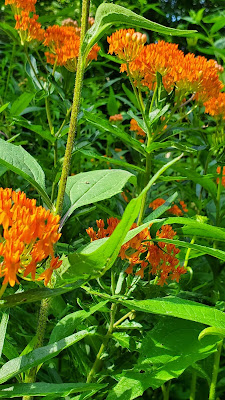Yogis,
As summer begins her swan song, I would like to introduce you to a plant you
might consider adding to next year’s garden. Her name is Asclepias Tuberosa,
but she also answers to Butterfly Weed or Pleurisy Root. As a member of the
milkweed family she plays an important role in the landscape.
There isn’t any other plant in my garden that has as many
stages of interest as butterfly weed. It all begins in spring as her upright stems
carrying thin lance shaped leaves begin their rise. As a perennial she will
return each year with no intervention on your part, reaching a height of about
2 feet at maturity.
As summer arrives large flat-topped clusters of long lasting brilliant orange flowers begin opening on the tops, catching your eye each time you pass. And as you would imagine from her name, several varieties of butterflies begin to arrive for her nectar, including Monarchs who use her as a host plant to lay eggs. In fact, the milkweed family of plants is the only place Monarchs reproduce. An important and distinctive honor she carries!!
As the monarch caterpillars emerge, they spend the next several
days eating the leaves of butterfly weed which contain a toxin they need for
metamorphosis. They fatten up nicely and head off to form their chrysalis. I
love how their black antennae look like horns.
In the meantime, as the flowers fade, large pods filled with seeds begin to form. Now it’s the milkweed bugs turn to arrive to lay their eggs and raise their young on the stems and pods. Hundreds of them! Bright orange and black, they stay solely on the butterfly weed as they are specialists, with juveniles requiring the seeds of milkweed plants for growth. Her toxins when ingested protect them too from predators. Once again butterfly weed to the rescue!
As if that isn’t enough, the milkweed bug’s activities help open the pods revealing hundreds of seeds each attached to a white silky hair. The wind will catch this weightless fluff and send the large seeds floating like fairies through the early autumn air, aiding in their dispersal. This fluff is even used as a hypoallergenic pillow filling.
You can start your butterfly weed from plant, lay seeds in the fall or if you are lucky, one of the fairies may land in your yard and surprise you.
As the days begin to cool, butterfly weed begins to die back.
The monarchs, bumblebees and milkweed
bugs too will disappear but will remember where to come next spring to continue
this miraculous life cycle.
Thank you butterfly weed,
SARAH




No comments:
Post a Comment